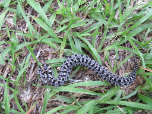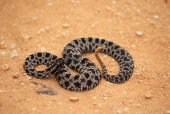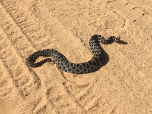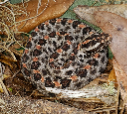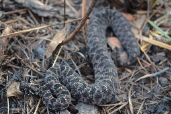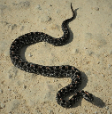Dusky Pygmy Rattlesnake (Sistrurus miliarius barbouri)
Description: Adults of S. m. barbouri grow to between 14.0 and 29.9 inches in total length, which includes the tail. In a study that involved 103 males and 80 females, the average total length was 21.1 inches. Regarding the coloration, this subspecies has dorsal spots that are more rounded, usually has a whitish belly that is heavily flecked or mottled with black or dark brown, and generally has 23 rows of dorsal scales at midbody. This is a very small snake, but it is thick for its size. The body color varies from light to dark gray, and a lengthwise row of black or charcoal blotches disrupts a reddish-brown stripe running down the middle of the back. The tail is slender and ends in a tiny rattle. The head is distinct from the neck and has a black diagonal line just behind the eye. The coloration of juveniles is the same as described for adults, except the tail tip of juveniles is bright sulfur-yellow in color.
Habitat: Pygmy Rattlesnakes are commonly found in habitats including lowland pine flatwoods, hydric hammocks, prairies, around lakes and ponds, and along the borders of many freshwater marshes and cypress swamps. Possibly the habitat in which Dusky Pygmy Rattlesnakes are most frequently encountered, at least in southern Florida, is along the banks of canals running through marshes and prairies. This species can be locally very abundant, and it is often found in suburban neighborhoods where development encroaches into favorable habitats.
Range: This subspecies, S. m. barbouri, is found in the United States from all of Florida & Georgia, west through southern Alabama. Dusky pygmies are common across much of their range, though become rare in states outside of Florida & southeastern Georgia.
Found in these States:
AL |
FL |
GA
Venom: Wright and Wright (1957) include excerpts from Allen (1938) that describe how an assistant was bitten by S. m. barbouri in the Everglades and suffered severe pain and swelling for about 24 hours despite treatment. Allen also quotes some statistics: according to the Florida Reptile Institute, 28 people were bitten by this subspecies in Florida between 1935 and 1937 with no deaths. Though these bites are painful, they are not considered life-threatening to people or pets.
The venom contain disintegrins, notably barbourin which has a KGD (Lys-Gly-Asp) amino acid motif rather than the more common RGD (Arg-Gly-Asp) motif. This single amino acid alteration gives barbourin higher binding affinity for the fibrinogen receptor glycoprotein IIb/IIIa. This receptor plays an important role in the aggregation of platelets, which then leads to the formation of a blood clot – competitive inhibition of this receptor by barbourin will decrease platelet aggregation, and thus reduce clotting.
Diet: The diet of S. miliarius includes small mammals and birds, lizards, insects, and frogs, as well as other snakes. Pygmy rattlesnakes also include giant desert centipedes in their diet, which they hunt by active pursuit, grabbing and flipping the centipedes around while simultaneously injecting venom to prevent injury by the victim. They also ambush lizards such as skinks by using their tails as lures, as is common in many other species of vipers. Caudal luring becomes less effective for adults, as the prey size and type changes. Their feeding strategy becomes sit-and-wait, with individuals remaining in a coiled position for days at a time.
Reproduction: Adult females of S. m. barbouri give birth to between 5 and 7 young at a time. In a brood of 8 from Silver Springs, Marion County, Florida, each neonate measured between 6.2 and 6.8 inches in total length.[4
Status: Listed as Least Concern in view of its wide distribution, presumed large population, and because it is unlikely to be declining fast enough to qualify for listing in a more threatened category.
»» Kingdom: Animalia - Animals
»» Phylum: Chordata - Chordates
»» Subphylum: Vertebrata - Vertebrates
»» Class: Reptilia - Reptiles
»» Order: Squamata - Scaled Reptiles
»» Suborder: Serpentes
»» Clade: Colubroides
»» Family: Viperidae - Vipers
»» Genus: Sistrurus
»» Species: Sistrurus miliarius - Pygmy Rattlesnake
»» Subspecies: Sistrurus miliarius barbouri - Dusky Pygmy Rattlesnake
This article uses material from the Wikipedia article "Sistrurus miliarius barbouri", which is released under the Creative Commons Attribution-Share-Alike License 3.0. Content may have been omitted from the original, but no content has been changed or extended.
|



